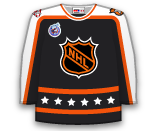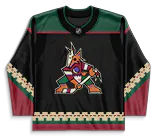Oesterle has two goals, three assists, 40 SOG, and eight PIMs across 38 games played but will be a healthy scratch Tuesday as Detroit takes on Washington. Robert Hagg will be Oesterle's replacement in Detroit's lineup.

Oesterle has two goals, three assists, 40 SOG, and eight PIMs across 38 games played but will be a healthy scratch Tuesday as Detroit takes on Washington. Robert Hagg will be Oesterle's replacement in Detroit's lineup.

Hagg has been a healthy scratch for the Red Wings' previous two games but will draw back into the lineup Tuesday as they take on Washington. The 28-year-old has three assists, 21 SOG, 14 PIMs and a -7 plus/minus through 17 games played this season.

Zadina has one goal, two assists, 18 SOG, eight PIMs and a -1 plus/minus through 15 games played with the Red Wings but will be a healthy scratch Tuesday vs. Washington. Jakub Vrana will be taking his spot in the Red Wings' lineup.

Vrana had six goals, five assists, four PIMs and a -2 plus/minus through 17 games played with Grand Rapids (AHL) and will return to the Red Wings lineup Tuesday. Vrana had a goal and two points in two games prior to entering the NHL and NHLPA's Player Assistance Program on October 19th.

Bryson has been a healthy scratch for the Sabres' previous three games but will draw back into the lineup Tuesday as they take on the Toronto Maple Leafs. The 25-year-old has a goal, seven assists, 22 SOG, and a -19 plus/minus through 43 games played this season.

Bahl was a healthy scratch for the Devils' previous game but will draw back into the lineup Tuesday as they take on Montreal. The 22-year-old has a goal, an assist, 12 SOG, 19 PIMs and a -2 plus/minus through 21 games played this season.

Stanley has been a healthy scratch for the Jets' previous three games but will draw back into the lineup Monday vs. the New York Rangers. The 24-year-old has an assist, eight SOG, 13 PIMs and a -2 plus/minus through 11 games played this season.

Gagner was a healthy scratch for the Jets' game last night but will draw back into the lineup as Cole Perfetti deals with an undisclosed injury. The 33-year-old has eight goals, six assists, 74 SOG, eight PIM and a -3 plus/minus through 44 games played this season.

Bellows has one goal, 24 SOG, six PIMs and a -5 plus/minus through 17 games this season but will be a healthy scratch Monday vs. Calgary.

Sanheim has four goals, 12 assists, 80 SOG, 34 PIMs and a -7 plus/minus through 57 games this season but will be a surprising healthy scratch Monday vs. Calgary. Olle Lycksell will take his spot in the Flyers' lineup as they go back to six defensemen for this game.

Megna has been a healthy scratch for Seattle's previous six games but will draw back into the lineup Monday as they take on his old team, the San Jose Sharks. The 30-year-old has a goal, 11 assists, 49 SOG, 21 PIMs and a +4 plus/minus through 49 games played this season between San Jose and Seattle.

Soucy has two goals, eight assists, 63 SOG, 41 PIMs and a +14 plus/minus through 56 games this season but will miss Monday's game vs. San Jose as he is a healthy scratch. It is the first game this season where the 28-year-old has sat.

Ritchie has six goals, eight points, 46 SOG, 23 PIMs and a +2 plus/minus through 34 games played this season but will be a healthy scratch Monday vs. Philadelphia. Adam Ruzicka will take his spot in the Flames lineup.

Ruzicka has six goals, 20 points, 59 SOG and eight PIMs through 40 games this season and will draw into the Flames' lineup Monday vs. Philadelphia. Brett Ritchie will head to the press box as Ruzicka takes the ice Monday.

Gilbert has been a healthy scratch for the Flames' previous two games but will draw back into the lineup Monday vs. Philadelphia. The 26-year-old has a goal, two assists, eight SOG, and 20 PIMs across 12 games played this season.

Kaut had a goal, five assists, eight PIMs and a +1 plus/minus with the San Jose Barracuda (AHL) since being dealt from Colorado weeks ago and has been recalled by the San Jose Sharks for the first time Monday with the intention to draw into the Sharks' lineup for the first time. In 27 games with the Colorado Avalanche before the deal, he had a goal, two assists, and 24 SOG.

Braun has one assist, 30 SOG, 19 PIMs and a +2 plus/minus through 36 games this season but will head to the press box Monday as Olle Lycksell draws back into the lineup.

Lycksell was a healthy scratch for the Flyers' previous two games but will draw back into the lineup Monday vs. Calgary. The 23-year-old has yet to pick up a point across four games played and has three SOG and two PIMs.

Kaut had a goal, five assists, eight PIMs and a +1 plus/minus with the San Jose Barracuda (AHL) since being dealt from Colorado weeks ago and has been recalled by the San Jose Sharks for the first time Monday. In 27 games with the Colorado Avalanche before the deal, he had a goal, two assists, and 24 SOG.

Gauthier was dealt to Ottawa Sunday alongside a seventh-round pick for Tyler Motte from the New York Rangers and will make his Senators' debut Monday. The 25-year-old had six goals, three assists, 36 SOG, four PIMs and a -5 plus/minus through 40 games with the Rangers this season.
